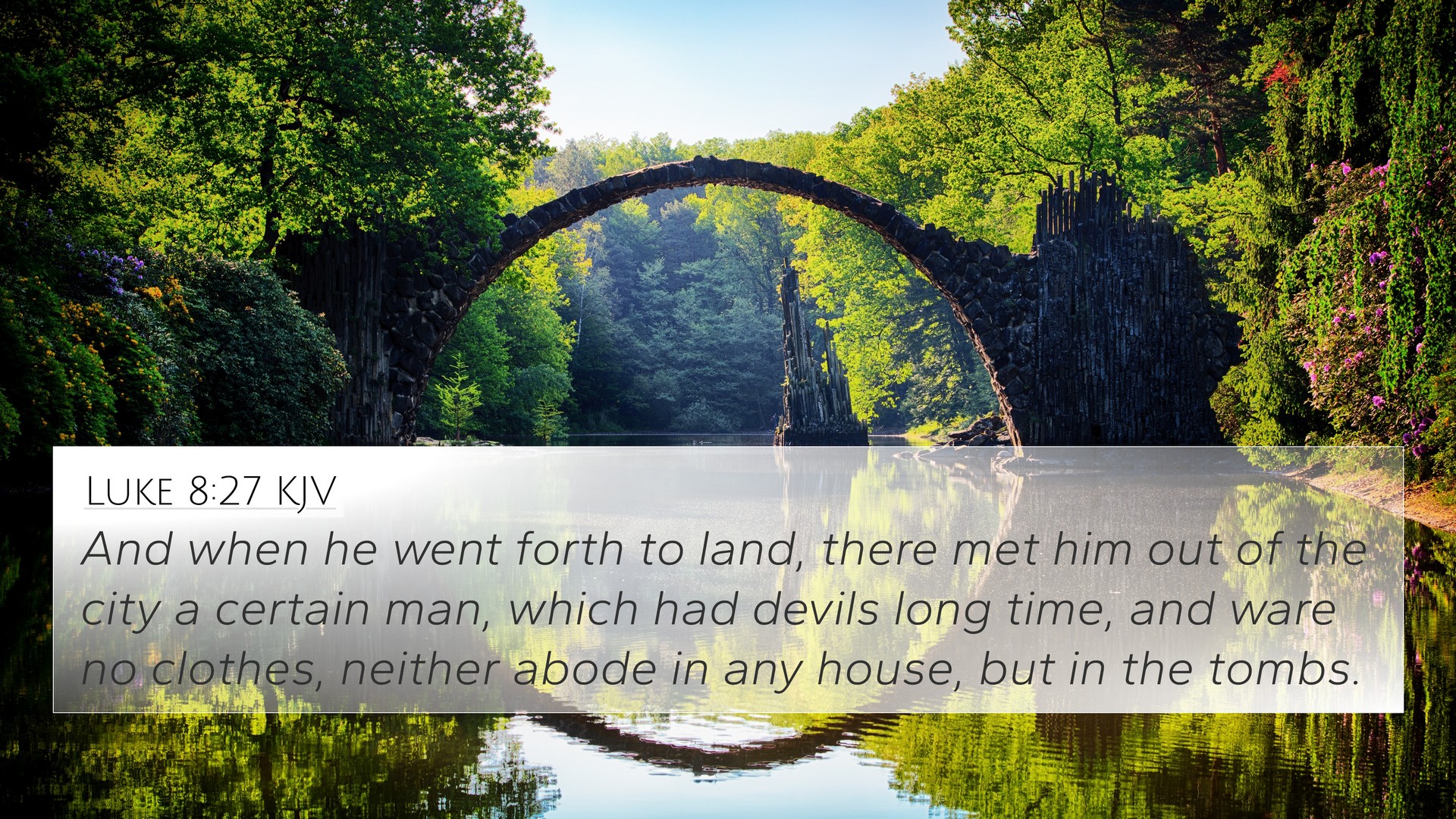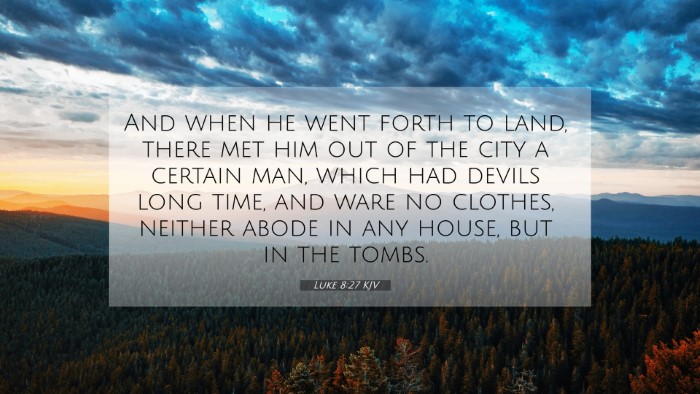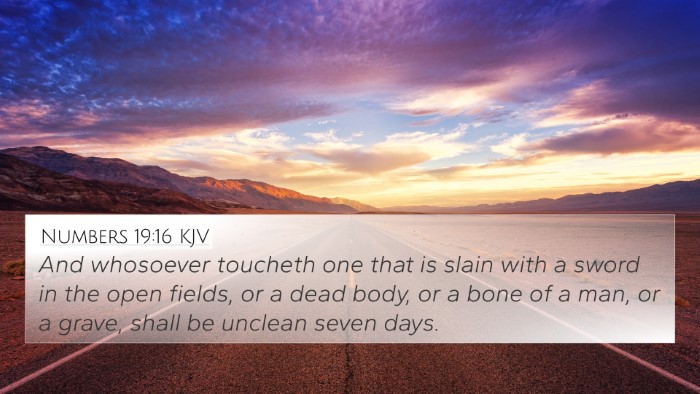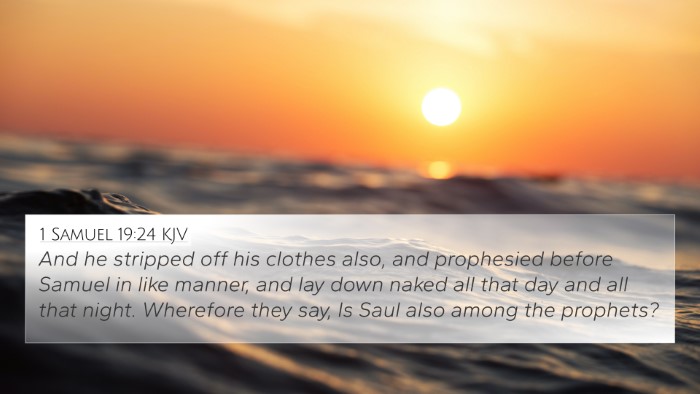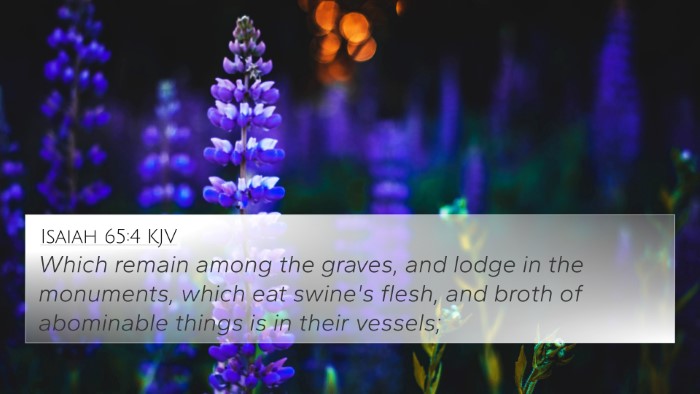Meaning and Interpretation of Luke 8:27
Verse Reference: Luke 8:27 - "And when he went forth to land, there met him out of the city a certain man, which had devils long time, and wore no clothes, neither abode in any house, but in the tombs."
This verse introduces a significant encounter between Jesus and a man possessed by demons, providing deep insights into the nature of Jesus' ministry, the plight of humanity, and the power of divine intervention. The commentaries from Matthew Henry, Albert Barnes, and Adam Clarke shed light on various aspects of this narrative.
Contextual Analysis
Luke 8:27 occurs in the broader context of Jesus' ministry, where he actively demonstrates his authority over both natural and supernatural realms. The previous passages describe the calming of the storm, emphasizing his power over nature, leading directly into the confrontation with demonic forces.
Commentary Insights
- Matthew Henry: He highlights the man's tragic condition as one of extreme suffering and isolation. The mention of the tombs signifies death and despair, contrasting with the life Jesus brings. Henry also notes that the man's lack of clothing symbolizes his lost humanity and the degradation caused by sin and evil spirits.
- Albert Barnes: Barnes elaborates on the nature of the demonic possession, explaining how it manifested in violent and erratic behavior. He emphasizes the social implications, as this man was shunned by society, living among the tombs, depicting a deep spiritual desolation that accompanies spiritual oppression.
- Adam Clarke: Clarke provides a detailed interpretation of the demons' identity and the implications for Jesus' mission. He suggests the encounter serves as a dramatic illustration of Jesus' authority over evil, a foretaste of his victory over sin and death through the cross. Clarke also mentions the symbolism of tombs, associating them with spiritual death and the urgent need for redemption.
Thematic Connections
The themes prevalent in Luke 8:27 resonate throughout scripture, particularly in relation to the following cross-references:
- Mark 5:1-20: This passage parallels Luke 8:27 with a detailed account of the same event. Mark provides further context on the number of demons and their response to Jesus.
- Matthew 8:28-34: Similar to the previous references, this account agrees with the narrative of the possessed man but focuses on the geographical setting and the reaction of the townsfolk.
- Luke 4:33-35: This earlier encounter of Jesus with an unclean spirit demonstrates his authority, establishing a pattern of Jesus confronting evil entities.
- Isaiah 61:1: Jesus’ ministry is a fulfillment of this prophetic verse, where he frees the captives and the oppressed, echoing the liberation he offers to the demon-possessed man.
- Romans 6:23: The theme of death and the consequences of sin discussed in this verse parallel the transformation that the possessed man experiences through Christ.
- John 10:10: Jesus contrasts the thief, representing evil, with his purpose to provide life, hinting at the restoration of the man in Luke 8:27.
- Acts 10:38: This passage speaks of Jesus’ anointing to heal and deliver, reflecting the same power he demonstrates over the demonic in Luke 8:27.
Application and Reflection
The implications of Luke 8:27 extend beyond the immediate narrative, opening discussions on spiritual warfare, the nature of sin, and the transformative power of Christ in the lives of those tormented by evil. The verse invites modern readers to reflect on their own spiritual condition, the influence of evil, and the hope of liberation found in Christ.
Cross-Referencing Insights
Utilizing a Bible cross-reference guide allows for deeper study of how scripture prevails in its interconnectedness. An integrated approach aids in recognizing Bible verses that relate to each other, enriching one’s understanding of the Bible as a seamless narrative of God’s redemption.
Tools for Bible Cross-Referencing
To explore connections deeply, consider the following tools:
- Bible Concordance: Provides a comprehensive index of words and themes.
- Cross-Reference Bible Study: Techniques to draw parallels and similarities among various scriptures.
- Bible Reference Resources: Various physical and online materials that offer exhaustive references for deeper insight.
- Bible Chain References: Follow themes and characters through links in biblical texts.
Finding Cross-References
For those asking, How to find cross-references in the Bible, it’s essential to approach the text dynamically, considering both thematic and contextual elements that bind verses together.
Conclusion
Luke 8:27 encapsulates a critical moment in Christ’s ministry that reveals profound truths about sin, suffering, and salvation. By understanding this verse and utilizing the tools available for cross-referencing Biblical texts, readers can better grasp the transformative work of Jesus and its application in their lives today.
